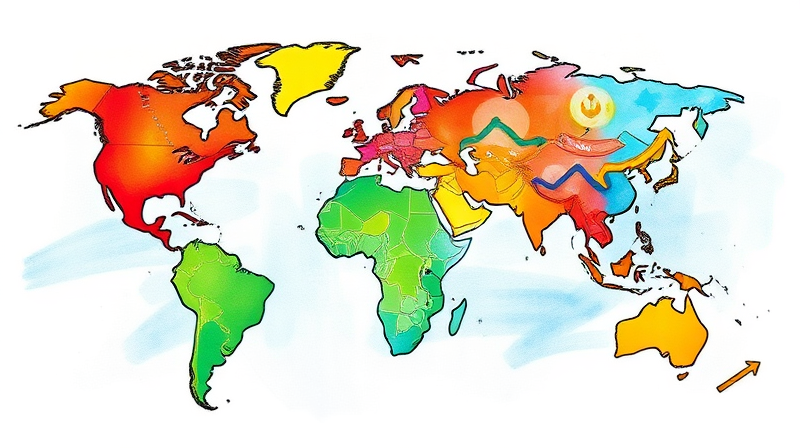Explore the trends and key drivers shaping emerging market investments in 2025.
Market Performance and Outlook
Emerging markets have begun 2025 with renewed momentum, as evidenced by the MSCI Emerging Markets IMI Index rising approximately 1.7% during the first quarter. Investors have been pleasantly surprised by this early strength, especially after years of lagging returns relative to developed equities. In 2024, emerging market equities added 7.7% through November, though still underperformed the MSCI World Index, which jumped 21.9% in the same period.
Analysts maintain a positive outlook for emerging market equities in 2025, even as volatility remains a possibility. Key supporting factors include outperforming currencies, resilient fiscal metrics, and a widening growth gap favoring emerging markets. Perhaps most striking is that equities trade at a 50% discount to developed markets on a price-to-book basis, the largest discount ever recorded.
This valuation gap, coupled with improving economic fundamentals, suggests that emerging markets may be poised for continued gains. Central banks in the region have room for cautious easing, and governments are leveraging stimulus measures to sustain growth momentum.
Regional Performance and Drivers
The dispersion of returns across regions highlights the diversity of emerging markets. Below is a summary of key markets and their defining characteristics in early 2025.
China: After prolonged weakness, China’s markets have bounced back as Beijing rolled out stimulus to support property and technology sectors. With its weight in emerging indices down to 26% from a peak of 42%, the market offers an attractive entry point with limited downside risk.
Taiwan: Fueled by Taiwan Semiconductor’s expansion and the broader AI boom, Taiwan emerged as a top performer in 2024. Its near 10% index weighting underscores the influence of tech giants on regional returns.
India: The market softened in early 2025 amid profit-taking and cooling economic indicators. Nevertheless, India’s long-term narrative remains intact, driven by robust internal demand drivers, favorable demographics, and ongoing policy reforms.
Brazil and CEEMEA: Select countries, notably Brazil, have benefited from improved commodity prices and stronger fiscal discipline. Meanwhile, regions such as Central Eastern Europe, the Middle East, and Africa experienced a boost from better macro conditions and renewed investor appetite.
Key Investment Themes and Considerations
- Trade Policy and Tariffs: New reciprocal tariffs on Chinese exports to the U.S. add complexity, but may accelerate China’s pivot toward domestic innovation and consumption.
- Monetary Policy and Inflation: Emerging market central banks face a balancing act
- Market Diversification: With China’s share receding, opportunities are spreading across sectors and geographies, reducing concentration risk.
- Earnings Trends: Relative to developed markets, emerging market companies could deliver a sustained earnings edge, supported by reopening economies and cost efficiencies.
- Valuation Opportunities: Historically low forward P/E differentials versus the S&P 500 suggest a compelling entry point for long-term investors.
Beyond these overarching themes, investors should remain vigilant about geopolitical shifts and policy changes in major economies. The interplay of U.S.-China relations, regional trade agreements, and domestic reforms will continue to shape risk and reward profiles.
Investment Implications
Given the attractive valuations and improving fundamentals, several strategic considerations emerge for portfolio construction in 2025.
- Consider increasing allocations to emerging equities around mid-year when trade tensions may peak.
- Emphasize markets with strong policy support, such as China and selective CEEMEA countries.
- Balance currency risk by diversifying across both dollarized and local-currency assets.
- Monitor inflation and rate policy shifts to time exposure tactically, particularly in markets sensitive to capital flows.
- Leverage sector themes—like technology in Taiwan and consumer growth in India—to capture structural upside.
Active management and flexible exposure can help investors navigate potential volatility. Tactical overweight positions in undervalued regions, combined with hedges against currency swings, may enhance risk-adjusted returns.
Economic Fundamentals and Navigating Volatility
Emerging markets enter 2025 backed by a sturdy economic backdrop. Faster growth rates, stable inflation, improving current account balances, and low public debt levels provide a resilient foundation. The post-pandemic era has seen a wave of structural reforms, fiscal discipline, and credit metric improvements, leading to more sovereign rating upgrades than downgrades in 2024.
However, risks remain. A tilt toward protectionism in major economies could dampen trade flows, while inflationary pressures from tariff pass-through may strain corporate margins. Investors must weigh these headwinds against the tailwinds of solid domestic demand and stimulative policies.
Stress-testing portfolios for scenarios—such as a sharp U.S. Fed pivot, renewed Chinese stimulus packages, or an unexpected global growth slowdown—can provide insight into potential outcomes and help calibrate risk exposures.
Conclusion
Emerging markets present a unique blend of opportunity and complexity in 2025. The combination of undervalued equities, improving regional fundamentals, and diversification benefits makes this asset class a compelling addition to global portfolios. Yet, success will depend on disciplined, research-driven approaches that account for evolving trade dynamics, monetary policy shifts, and idiosyncratic country risks.
By staying informed on key themes, balancing risk factors, and adopting a flexible stance, investors can harness the potential of emerging markets to enhance long-term returns. As the investment landscape evolves, those who remain agile and attuned to global trends will be best positioned to capitalize on the opportunities ahead.
References
- https://www.vaneck.com/us/en/blogs/emerging-markets-equity/emerging-markets-policy-uncertainty-tempers-a-strong-start-to-2025/
- https://www.ssga.com/us/en/institutional/insights/5-emerging-market-wildcards-for-2025
- https://www.pinebridge.com/en/insights/2025-emerging-market-fixed-income-outlook
- https://www.eastspring.com/2025-market-outlook
- https://www.ashmoregroup.com/en-in/document/2025-emerging-markets-outlook
- https://www.jpmorgan.com/insights/global-research/outlook/market-outlook
- https://institutional.fidelity.com/advisors/insights/topics/investing-ideas/why-2025-might-be-the-year-for-emerging-markets










